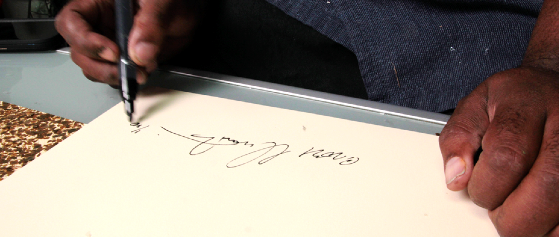Published by Exhibition A
Dashiell Manley's Elegy: A Journey of Meditation, Contemplation, and Growth
When artists immerse themselves in their craft, it's a testament to their devotion. For Dash, his practice is more than just painting – it's a spiritual journey, a form of therapy, and an evolving meditation. The Elegy Paintings, one of Dash's most well-known series, embody this commitment. Originating as a way to find peace and solace in both his studio and personal life, these works have become an essential part of his being. Their creation is an act so ingrained in his psyche that Dash reveals, "There's no way I can't make these."
Several years ago, the Elegy series emerged during a period when Dash felt increasingly burdened by the relentless surge of information and the gravity of global events. Between 2012-2013, Dash undertook a project wherein he would transcribe the entire front of the New York Times using a watercolor pencil. He would then dilute the ink, giving rise to an abstract painting. This endeavor was meant to act as his bridge to the world, to humanity—an abstract reflection intended for contemplation. However, over time, what was meant to be a meditative act began to evoke feelings of anxiety and depression. In search of reprieve, Dash yearned for simplicity – a desire to create art that "didn't matter." Retreating to the confines of his studio, he sought to produce something purely for the joy of creation. The result? An intuitive mark on canvas, raw and unrestricted. From that singular mark, the Elegy series was born.
NYT. SUNDAY, JUNE 30, 2019, 2020
Image credit Jeff Mclane
However, over time, what was meant to be a meditative act began to evoke feelings of anxiety and depression. In search of reprieve, Dash yearned for simplicity – a desire to create art that "didn't matter." Retreating to the confines of his studio, he sought to produce something purely for the joy of creation. The result? An intuitive mark on canvas, raw and unrestricted. From that singular mark, the Elegy series was born.
Over time, Dash's process for these paintings became ritualistic. Self-imposed rules emerged, such as only making a single attempt at each mark and never retouching in real-time. The outcome wasn't the sole focus. It was about the journey, the experience, and the cathartic release. Initially, these elegy paintings served a dual purpose: they memorialized worldly events and offered Dash a way to process and release his feelings towards them. It was his unique way of dealing with the negative energy from distressing news stories.
views, F.B., 2021
Oil on linen
84 x 60 in
Years later, the significance of the Elegy series remains, albeit in a more general form. They've seamlessly integrated into Dash's daily routine, becoming as essential as morning coffee or school runs. Much like a dedicated swimmer setting aside time for laps, Dash commits to his canvas. This discipline keeps him grounded, ensuring he remains present and continuously hones his craft.
Detail of an Elegy painting
This deep-rooted connection to the Elegy paintings eventually led to the contemplation of creating visually distinct works, which capture the essence of meditation and introspection. Hence, he ventured into the realm of halftone paintings. Halftones, for the uninitiated, are a technique used to reproduce images using dots of varying sizes and spacing. When viewed from a distance, these dots blend to produce a broader range of tones, allowing for detailed reproductions of photographs and other artworks. This method served a dual purpose: extending the duration he spent with individual images and aligning with his fascination for optical illusions, the science behind visual perceptions, and the mechanics of industrial printing.
detachments. through passages (there and back) 2022. 2022.
Gouache, acrylic, graphite and oil stick on linen.
48x60in
For our most recent collaboration with Dash, a hand-finished print edition, titled Elegy Study (a Collapse), Dash unveils an innovative concept that he has been contemplating for some time: the fusion of the Elegy painting style with the halftone technique. In this edition, the primary canvas features an Elegy painting, created exclusively for this collaboration, and rendered in intricate halftones. To bring each piece in this collection to completion, a meticulously painted grid, expressed in varied shades of blue, overlays the foundational print.
The grid is a recurring element in Dash's artwork that has evolved over time. Rooted in both function and design, the grid finds its inspiration from both graph paper and Japanese room dividers. These dividers, with their 10 x 10-inch gridded screens, once adorned his childhood home, reappropriated as window screens. This ever-present motif has continued to manifest throughout Dash's artistic journey.
Left: An Elegy painting, rendered in half-tones, that became the foundational print for this series.
Above: Each print received hand-painted grid embellishments by Dash in his studio.




